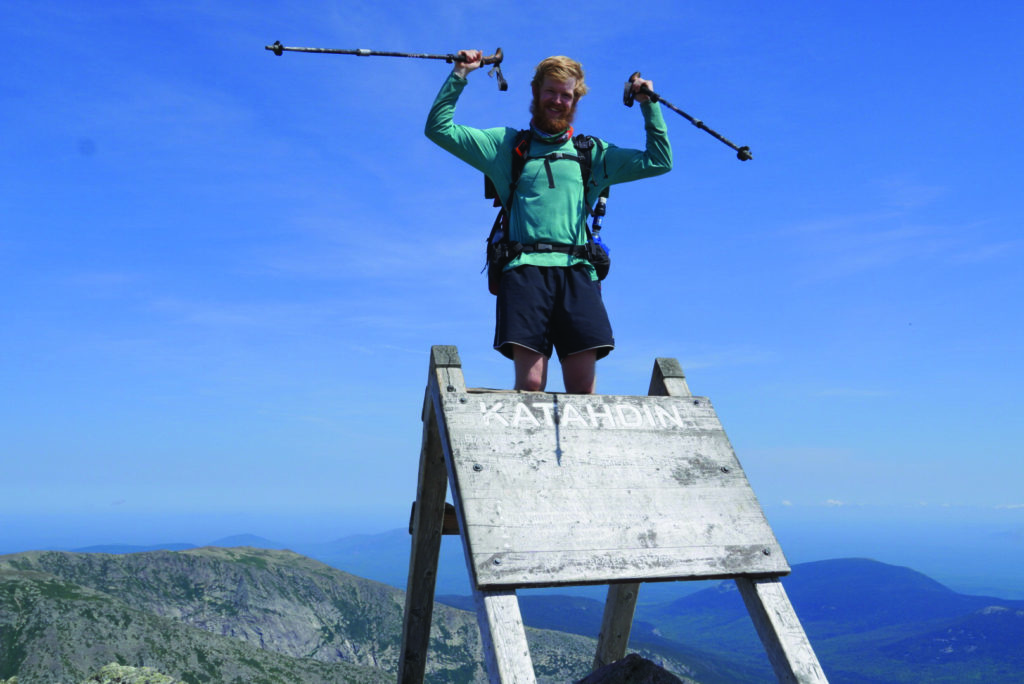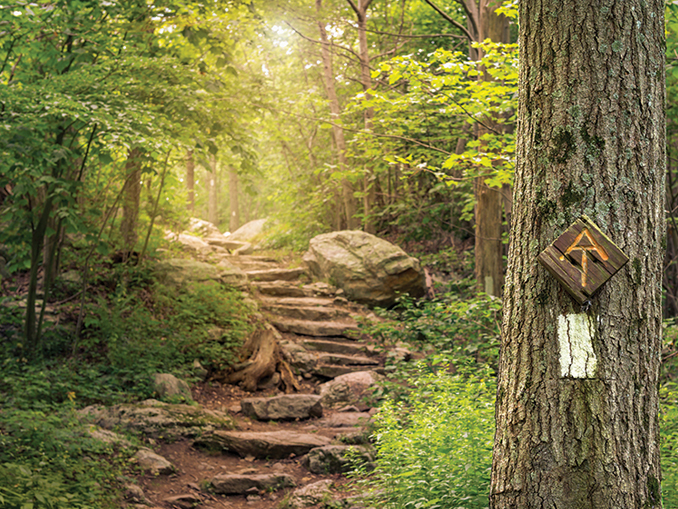 by Ryan Trismen, Andover, Massachusetts, Ryantrismen@gmail.com
by Ryan Trismen, Andover, Massachusetts, Ryantrismen@gmail.com
In 2021, I hiked 2,193.1 miles along the entire length of the Appalachian Trail from Springer Mountain, Georgia, all the way to Mount Katahdin, Maine, and it was one of the best things I’ve done in my life. It was a dream I have had since I was 12 years old, when I first read Bill Bryson’s A Walk in the Woods. I remember reading Bryson’s description of the trail’s rich history and interesting characters coming from all walks of life to experience an epic journey of walking the Appalachian Trial.
I wanted to face that challenge, to chart out a course on my own, and try to absorb some of the magnificence that the Appalachian Mountains exude. But throughout high school, college, and even my first job, I never felt like it was the right time to go. It was only when I was 25 and idle during the pandemic that I felt stuck and needed to follow my heart. I was blessed to be in a decent financial position and decided it was the right time, so I quit my job to pursue that dream.
When I finally made the decision to start the Appalachian Trail, I was focused on the physical challenge and wasn’t thinking as much about the mental ups and downs that would make or break my journey. I found that I had to tweak my worldview and understanding of myself in order to have the mental fortitude to overcome the persistent discomforts and ever-reaching consistency of the trail. It required planning, fluidity, and willingness to roll with the punches. As they say, “If you fight the trail, it will crush you.”
Stop 1: Preparation
Preparing for a long-distance hike involved hours of research about how best to carry a life on one’s back. Stuffing a sleeping bag, sleeping pad, tent, cooking set, fuel, first aid kit, water filter, jackets, clothing, and a food bag all into one pack was no easy task. Adding in the heavy-duty camera I chose to bring, my initial pack weighed in at a whopping 40 pounds, which took weeks to fine-tune and adjust down to what I truly needed. Every piece of gear needed to be evaluated as extra ounces that I would feel in the thousands of steps I would take each day. I elected not to bring a pillow to save a measly 2.5 ounces, and certain food combinations were selected based on calories per ounce (ramen hardly weighs anything). A general food resupply strategy had to be made—how much food was I going to carry in certain sections of the trail? Would I hitchhike, walk, or shuttle into town? How would I get the right blend of nutrients to keep going? Finally, at the behest of my worried family, I reviewed an action plan for worst-case scenarios. Although the Appalachian Trail is not inherently dangerous, things like broken bones, Lyme disease, and hypothermia certainly weren’t out of the question.
Stop 2: The “Shoulds”
But most importantly for me, deciding to undertake this five-month hike meant hitting pause on what I call the “shoulds.” I should have been furthering my career, I should have been saving more money, and I should have been more productive. Pushing aside what I believed I should do with my time was not easy, but I never once regretted that decision. Ultimately, that is the aspect of my trip that I’m most proud of: I fully invested in myself. I completely threw myself into what I hoped would make me the happiest, and the trail ended up giving me more novel experiences than my original “shoulds” could ever provide—opportunities to test who I really was, challenge what I could handle, and learn to float in the unexpected.
Stop 3: “Type B” Fun
Enjoying the trail isn’t the typical type of fun like spending a night out, sitting back and watching a movie, or getting dressed up for date night. Instead, “Type B” fun, or maybe better known as “embrace the suck,” was what we hikers were forced to do when “Type A” fun wasn’t available. There were many chances to face down tough situations throughout the trail, and my fellow hikers and I found it easiest to make light of the challenge by leaning into the discomfort and misery:
- Oh, it’s been raining for three weeks straight and all my clothes are dripping wet? Awesome!
- Are you telling me there are two gigantic wolf spiders in the privy? Man, I’ve never seen a wolf spider before!
- We have to hike eighteen miles in -4 degree Fahrenheit weather in the Smokies? Don’t tempt me with a good time!
The list goes on and on, but embracing the suck is a lesson that has stayed with me. If you can lean into the expected discomforts, be happily bewildered at some misfortunes, and take any excuse to laugh in a tough scenario, the trek becomes a lot more manageable.
Stop 4: The Trail Provides
There were certainly days or sections of the trail where I needed to lean on someone, anyone. A phrase commonly heard while hiking is “the trail provides.” I’ve learned that this really means, “the hikers and trail community provide.” If I complained about not having enough stove fuel, I would have four hikers thrusting their fuel canisters at me. I can’t even count the number of times that I was low on food, rounded a corner, and a kind person from a nearby town had set up a stove with cheeseburgers ready for hungry hikers. While I may have started the trail alone, I certainly didn’t end it alone. I hiked with people as an organized “tramily” (trail family) and was with others for just a week, a day, or an evening meal. That’s the magic of living on the trail—people come and go, never to be seen again. But what remains among the fluidity is a sense of purpose. We helped each other through the challenge, as completely random individuals bound together by one goal.
Stop 5: Being Present
I am generally a person who likes to complete his to-do list. I like to get ahead on tasks, so in some future, nonexistent world, I can have some moments of pure relaxation. But that moment of pure relaxation rarely comes. There is always an opportunity to get ahead, always an upcoming responsibility. But the trail has a way of forcing you to be in the present, equally through awe or discomfort. Without the constant pressure to look forward, I found that I felt my emotions more fully. Being absolutely present led to days where I was tearfully emotional in the woods by myself or buoyantly floating over rocks and roots. I took advantage of my time alone to overcome the walls surrounding aspects of my life that were inconvenient to think about, and I chipped away until I could come face to face with how I truly felt. Sure, I didn’t resolve all my flaws or become my idealized self, but I did make another step toward coming to peace with who I really am. I recognized that my habit of looking forward didn’t allow me to fully feel or be present. Today, I still catch myself reverting to those old tendencies, and I have to remind myself—“turn off the phone, listen fully, and stop trying to always get ahead.”
Stop 6: Physical Awareness
I was never more in tune with my body than I was during my thru-hike. After a month or two on the trail, I would notice the texture on the handles of my trekking poles or how my foot rolled forward from the center of my heel to the end of my toes. I instinctively knew how many tenths of a mile I walked in the past hour and at what speed I was walking. I could sense how much walking a twisted ankle could take or when I needed to slow down my heart rate. Now, as a full-time student, I still try to center myself by reentering my own body. I find it too easy when overwhelmed or focused on work to ignore the very body that I relied on for so many months to carry me from Georgia to Maine. I try to concentrate and embrace what I feel at present, whether it be how I am breathing, the way my back rests upon my chair, or how my tongue sticks to the roof of my mouth when I focus. By noticing the little things in my own body and around me, it’s easy to be more present.
Stop 7: Post-Trail Blues
I can’t express the feeling of hiking for over five months and finally getting to the summit of the last mountain. The joy and almost crippling exuberance that washed over me as I saw the sign for the northern terminus isn’t a feeling I could ever replicate. The triumph, pure relief, exhaustion, and bewilderment all hit me with equal force.
 But coming back to reality after this adventure isn’t the easiest task. I’m able to distract myself with schoolwork, but staring at a computer for eight hours a day just doesn’t come close to conquering mountains. Many hikers experience post-trail depression, in that their normal nine-to-five jobs don’t live up to the rapid ups and downs of the challenges and experiences of trail life. I don’t think there’s any real solution to this but to work on planning the next adventure and try to make everyday life as much like the trail as possible. So, even while in school and work, I’m trying to pursue what makes me happy, allow myself to be fully present, battle indifference, and lean on loved ones. There are many stories of thru-hikers embarking on the Appalachian Trail to find themselves, confront themselves, see a sign from God, or otherwise gain a higher understanding of what it means to be oneself. In the end, I didn’t unearth a dark secret in myself or learn how to perfectly be at peace with who I am. I guess I just felt more myself than I had before, and I think that may be just as valuable.
But coming back to reality after this adventure isn’t the easiest task. I’m able to distract myself with schoolwork, but staring at a computer for eight hours a day just doesn’t come close to conquering mountains. Many hikers experience post-trail depression, in that their normal nine-to-five jobs don’t live up to the rapid ups and downs of the challenges and experiences of trail life. I don’t think there’s any real solution to this but to work on planning the next adventure and try to make everyday life as much like the trail as possible. So, even while in school and work, I’m trying to pursue what makes me happy, allow myself to be fully present, battle indifference, and lean on loved ones. There are many stories of thru-hikers embarking on the Appalachian Trail to find themselves, confront themselves, see a sign from God, or otherwise gain a higher understanding of what it means to be oneself. In the end, I didn’t unearth a dark secret in myself or learn how to perfectly be at peace with who I am. I guess I just felt more myself than I had before, and I think that may be just as valuable.

